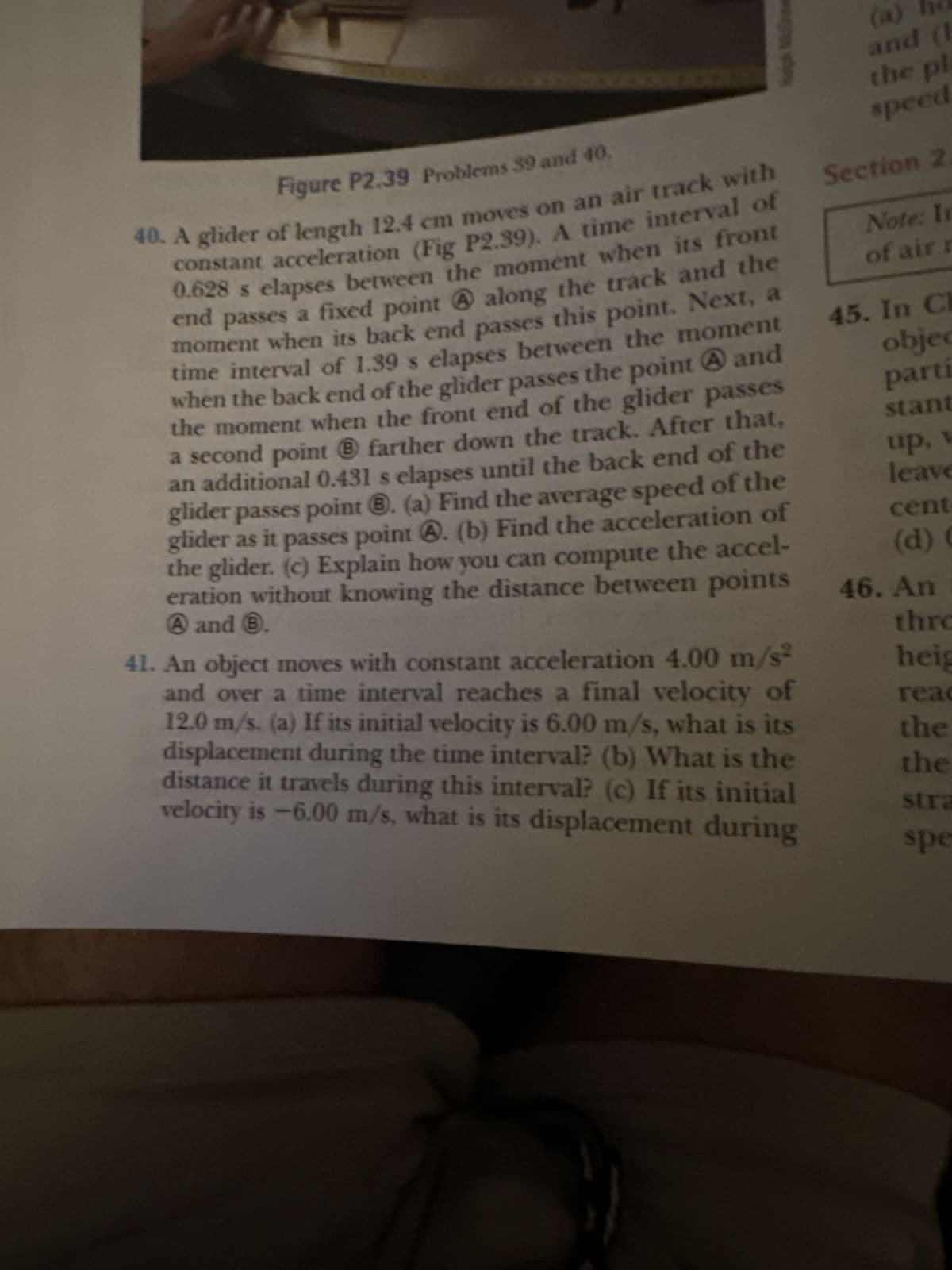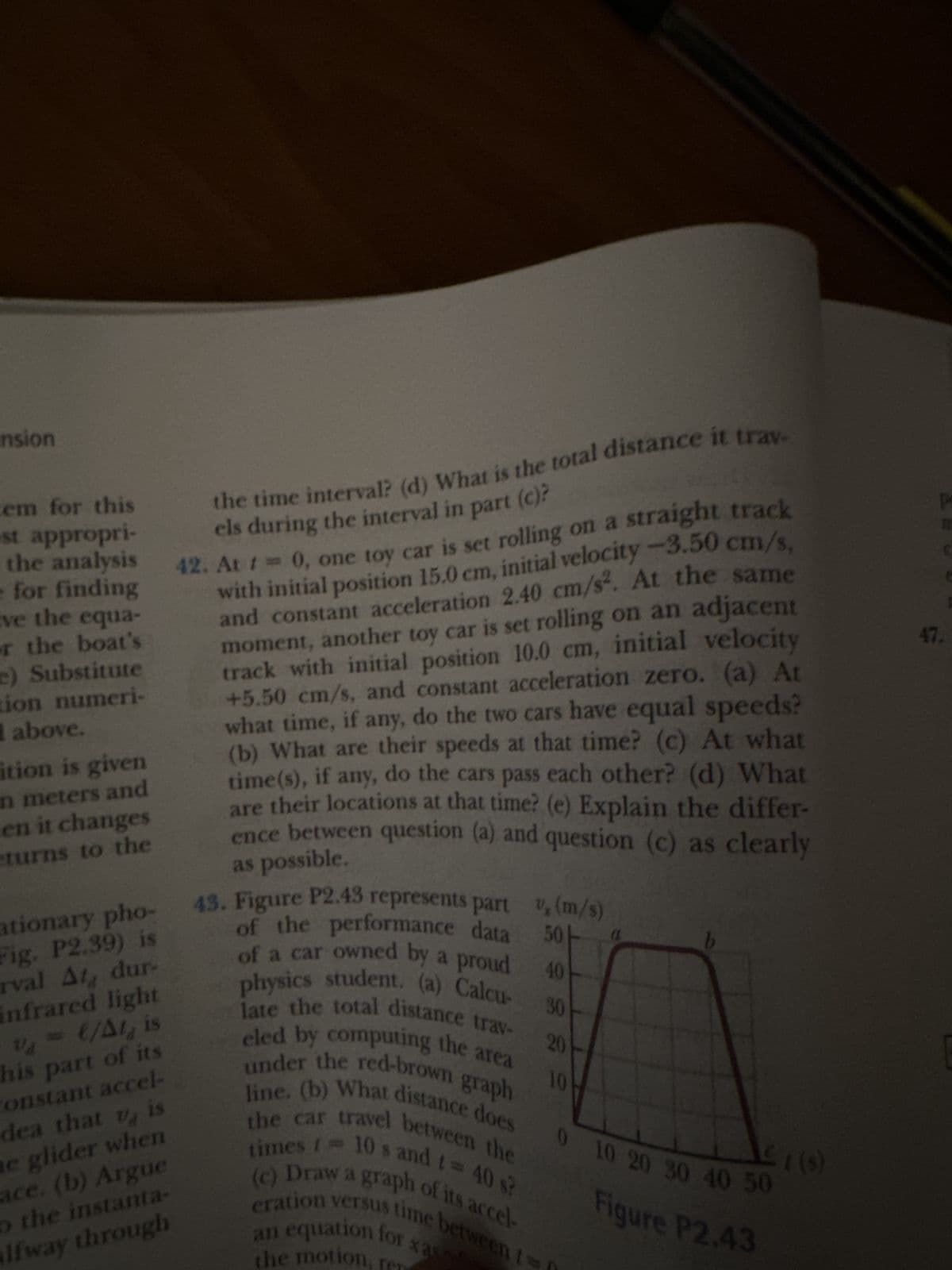A and Ⓡ. 41. An object moves with constant acceleration 4.00 m/s² and over a time interval reaches a final velocity of 12.0 m/s. (a) If its initial velocity is 6.00 m/s, what is its displacement during the time interval? (b) What is the distance it travels during this interval? (c) If its initial velocity is -6.00 m/s, what is its displacement during H T
A and Ⓡ. 41. An object moves with constant acceleration 4.00 m/s² and over a time interval reaches a final velocity of 12.0 m/s. (a) If its initial velocity is 6.00 m/s, what is its displacement during the time interval? (b) What is the distance it travels during this interval? (c) If its initial velocity is -6.00 m/s, what is its displacement during H T
College Physics
11th Edition
ISBN:9781305952300
Author:Raymond A. Serway, Chris Vuille
Publisher:Raymond A. Serway, Chris Vuille
Chapter1: Units, Trigonometry. And Vectors
Section: Chapter Questions
Problem 1CQ: Estimate the order of magnitude of the length, in meters, of each of the following; (a) a mouse, (b)...
Related questions
Question
Need help with question number 41, second picture have the last bit of the information.

Transcribed Image Text:Figure P2.39 Problems 39 and 40.
40. A glider of length 12.4 cm moves on an air track with
constant acceleration (Fig P2.39). A time interval of
0.628 s elapses between the moment when its front
end passes a fixed point A along the track and the
moment when its back end passes this point. Next, a
time interval of 1.39 s elapses between the moment
when the back end of the glider passes the point and
the moment when the front end of the glider passes
a second point ® farther down the track. After that,
an additional 0.431 s elapses until the back end of the
glider passes point ®. (a) Find the average speed of the
glider as it passes point . (b) Find the acceleration of
the glider. (c) Explain how you can compute the accel-
eration without knowing the distance between points
A and 6.
41. An object moves with constant acceleration 4.00 m/s²
and over a time interval reaches a final velocity of
12.0 m/s. (a) If its initial velocity is 6.00 m/s, what is its
displacement during the time interval? (b) What is the
distance it travels during this interval? (c) If its initial
velocity is -6.00 m/s, what is its displacement during
and (1
the pla
speed
Section 2.
Note: In
of air r
45. In Ch
objec
parti
stant
up, v
leave
cent
(d) (
46. An
thro
heig
reac
the
the
stra
spe

Transcribed Image Text:em for this
st appropri-
the time interval? (d) What is the total distance it trav-
els during the interval in part (c)?
for analysis 42. At 1 = 0, one toy car is set rolling on a straight track
with initial position 15.0 cm, initial velocity -3.50 cm/s,
and constant acceleration 2.40 cm/s². At the same
moment, another toy car is set rolling on an adjacent
track with initial position 10.0 cm, initial velocity
+5.50 cm/s, and constant acceleration zero. (a) At
what time, if any, do the two cars have equal speeds?
(b) What are their speeds at that time? (c) At what
time(s), if any, do the cars pass each other? (d) What
are their locations at that time? (e) Explain the differ-
ence between question (a) and question (c) as clearly
as possible.
nsion
ve the equa-
or the boat's
e) Substitute
tion numeri-
above.
ition is given
n meters and
en it changes
eturns to the
ationary pho-
Fig. P2.39) is
rval At dur-
Infrared light
V₁= €/At, is
his part of its
constant accel-
dea that u is
ne glider when
ace. (b) Argue
o the instanta-
Ifway through
Va
30
43. Figure P2.43 represents part , (m/s)
of the performance data 501
of a car owned by a proud 40
physics student. (a) Calcu-
late the total distance trav-
eled by computing the area
under the red-brown graph
line. (b) What distance does
the car travel between the
times = 10's and t = 40 s?
(c) Draw a graph of its accel-
eration versus time between t=
an equation for xas
the motion,
20
10
(
£1 (5)
0 10 20 30 40 50
Figure P2.43
p
47.
Expert Solution
This question has been solved!
Explore an expertly crafted, step-by-step solution for a thorough understanding of key concepts.
Step by step
Solved in 3 steps with 2 images

Knowledge Booster
Learn more about
Need a deep-dive on the concept behind this application? Look no further. Learn more about this topic, physics and related others by exploring similar questions and additional content below.Recommended textbooks for you

College Physics
Physics
ISBN:
9781305952300
Author:
Raymond A. Serway, Chris Vuille
Publisher:
Cengage Learning

University Physics (14th Edition)
Physics
ISBN:
9780133969290
Author:
Hugh D. Young, Roger A. Freedman
Publisher:
PEARSON

Introduction To Quantum Mechanics
Physics
ISBN:
9781107189638
Author:
Griffiths, David J., Schroeter, Darrell F.
Publisher:
Cambridge University Press

College Physics
Physics
ISBN:
9781305952300
Author:
Raymond A. Serway, Chris Vuille
Publisher:
Cengage Learning

University Physics (14th Edition)
Physics
ISBN:
9780133969290
Author:
Hugh D. Young, Roger A. Freedman
Publisher:
PEARSON

Introduction To Quantum Mechanics
Physics
ISBN:
9781107189638
Author:
Griffiths, David J., Schroeter, Darrell F.
Publisher:
Cambridge University Press

Physics for Scientists and Engineers
Physics
ISBN:
9781337553278
Author:
Raymond A. Serway, John W. Jewett
Publisher:
Cengage Learning

Lecture- Tutorials for Introductory Astronomy
Physics
ISBN:
9780321820464
Author:
Edward E. Prather, Tim P. Slater, Jeff P. Adams, Gina Brissenden
Publisher:
Addison-Wesley

College Physics: A Strategic Approach (4th Editio…
Physics
ISBN:
9780134609034
Author:
Randall D. Knight (Professor Emeritus), Brian Jones, Stuart Field
Publisher:
PEARSON